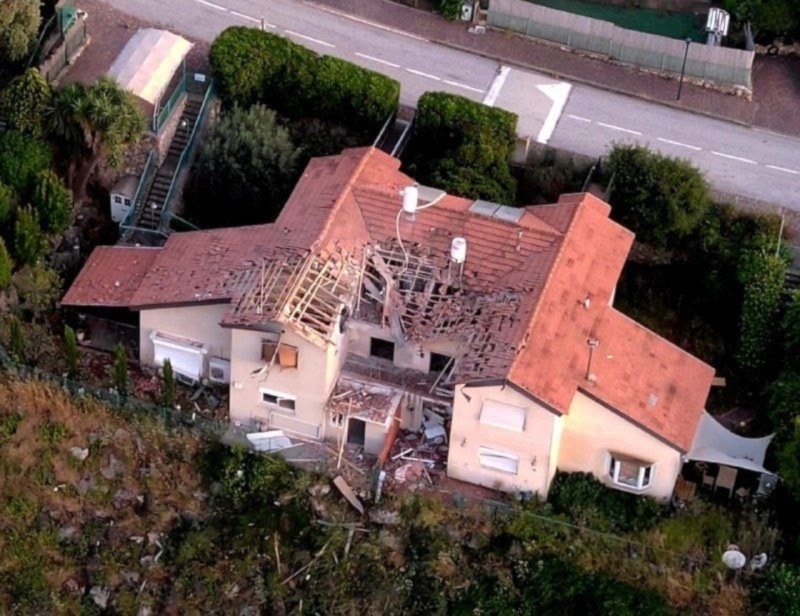Hezbollah bombards Israeli sites all over occupied north Palestine
Hezbollah bombards numerous Israeli locations and assembly points as the Israeli soldiers shelter themselves in the homes of settlers.
-

Aerial view of a building in the settlement of Metula suffering from extensive damages after being bombed by Hezbollah on Tuesday, May 7, 2024
The Islamic Resistance in Lebanon - Hezbollah announced Wednesday that it launched numerous operations against the Israeli occupation forces, inflicting extensive damage on the Israelis and their positions in northern occupied Palestine.
Hezbollah bombed a house used by the Israeli occupation forces as a shelter in the settlement of Metula and another one in the settlement of al-Manara. A similar operation took place in the settlement of Shlomi, wherein the Resistance bombed two houses being used by the IOF for military operations.
The Resistance continued bombing evacuated buildings used by Israeli soldiers, wherein two buildings were bombed in Hanita and another two were bombed in Avivim.
The Resistance launched precision missiles at the Israeli Raheb military site, engaging espionage equipment at the site and destroying it.
The Resistance also launched precision missiles and artillery strikes at the Malikiyah site, inflicting human and material casualties.
The operations continued throughout Wednesday afternoon as the Resistance bombed the headquarters of the Western command in the settlement of Yaara.
The Resistance also bombarded the headquarters of Unit 91 in the Branit barracks and the Israeli Summaqa military site in the occupied Lebanese Kfar Chouba Hills.
Extensive damages
Within occupied Palestine, Israeli media outlets acknowledged the paramount damage dealt to buildings attacked by Hezbollah in the northern settlements.
Israeli media reported that there was a direct strike by a missile in Metula, which did not activate the emergency alert system.
The Israeli media indicated that a rocket fired from Lebanon landed at the Goma junction, in the Upper al-Jalil, which led to the closure of the road to traffic and pedestrians.
One projectile landed in Moshav Gorn, while sirens sounded in the settlements of Shtula, Zarit, Shomra, and Even Menachem.
Meanwhile, the sounds of explosions were heard along the northern coastline, from Haifa to Nahariya and its surroundings, and smoke plumes were seen from afar.
In parallel, Israeli attacks on southern Lebanese villages continue, with the Israeli airforce bombarding Aita al-Shaab, Jabal Blat, Ramia, Tel al-Nahhas on the outskirts of Kfar Kila, al-Rayhan Heights, and Iqlim al-Tuffah Heights, an Al Mayadeen correspondent reported.
Al Mayadeen's correspondent in Southern Lebanon underlined that the Israeli occupation forces also bombed the outskirts of the town of Yaroun and the city of Khiyam.
Balance of terror
A new balance of terror has emerged in the North, one that "Israel" cannot live with even for a "single hour," an op-ed published by Israeli newspaper Maariv on Tuesday said.
Avi Ashkenazi, the military correspondent of the newspaper, recalled in his piece the course of confrontation, the balance of combat, and the rules of engagement between Hezbollah and the occupation since before the withdrawal from southern Lebanon in 2000.
"Any solution in the North requires decision-makers in Israel to work on dismantling this balance of terror," the author began by warning.
According to the Ashkenazi, Hezbollah Secretary-General Sayyed Hassan Nasrallah was able, before the Israeli withdrawal, and over the years, to create engagement rules in his favor in the "security belt in Lebanon," where "he decided that every Israeli attack on a civilian target would lead to rocket fire on Kiryat Shmona and settlements in the Galilee," and that the targets of the rocket launches varied between "open areas and inhibited ones."
Later, this led to the debate within the occupation entity about the withdrawal to intensify, he said.
The "Four Mothers" movement led a campaign calling for withdrawal from Lebanon without any agreement, on the grounds that the Israeli soldiers' operations in the "security zone" were not to defend the settlements but to protect themselves, their positions, and their transportation routes. In exchange for presenting a bleak military picture regarding the ability to secure a high level of security for the settlements in the event of withdrawal.
Meanwhile, Sayyed Nasrallah, who saw the internal Israeli disagreements and caught statements about an imminent withdrawal, decided to capitalize on his regional power.
Read more: Israeli academic: Nasrallah put to action battlefield unity with Gaza
Weeks before the withdrawal, Israeli shelling hit a civilian house in southern Lebanon, Ashkenazi said. Following the aggression, Hezbollah struck Kiryat Shmona without warning, and "previous constraints by the rules of the game" set by Sayyed Nasrallah himself, led to intensive missile barrages during the Israeli holiday season while the market was bustling with people, immediately emptying the settlement's streets, turning it into a ghost town for weeks, also leading to a decision to end the school year.
Sayyed Nasrallah succeeded weeks before the withdrawal in changing the balance of terror between "Israel" and Hezbollah, the author said. Since then, the boundaries of deterrence between the two sides have been tested more than once through the capture of the Israeli soldiers in the occupied Shebaa Farms in July 2006, as well as in other operations, then "came the Second Lebanon War, which, according to Nasrallah himself, changed the equation he tried to develop and maintain."

 5 Min Read
5 Min Read










